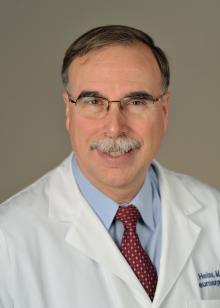
Clinical Neuroscience and Neurological Disorders
John D. Heiss, M.D. is the Head of the Surgical Neurology Branch and Program Director of the Neurological Surgery Residency Training Program in the NINDS. Dr. Heiss received both his B.S. in Biomedical Sciences and M.D. degree from the University of Michigan. He completed his surgical internship and his residency in neurosurgery at the University of Cincinnati College of Medicine. Prior to joining NINDS, Dr. Heiss was co-director of the Neuroscience Intensive Care Unit at the University of Cincinnati and a neurosurgeon in the Mayfield Neurological Institute. He completed a fellowship in neurosurgery research in the Surgical Neurology Branch before joining the senior staff of the Surgical Neurology Branch.
Dr. Heiss is board certified in neurological surgery and is expert in the supervision and conduct of clinical trials for CNS disorders. He is Vice-Chair of the Combined Neurosciences Institutional Review Board at the NIH and has served on numerous grant review panels.
Education & Training:
- Residency, University of Cincinnati College of Medicine, Neurosurgery, 1981 – 1987
- Surgical Intern, University of Cincinnati College of Medicine, 1980 – 1981
- M.D., University of Michigan, 1976-1980
- B.S., University of Michigan, Biomedical Sciences, 1974-1977
Research Interests:
Dr. Heiss is actively involved in clinical and translational research to improve the treatment of degenerative brain diseases, brain tumors, cancer pain, Chiari I malformation, and syringomyelia.
Dr. Heiss has clinical interest and expertise in the treatment of patients with Chiari I malformation, syringomyelia, peripheral nerve tumors, and brain tumors. His research interests include intracerebral drug delivery, gene therapy for Parkinson’s disease, treatment of severe, unremitting cancer pain with resiniferatoxin (RTX), and the natural history and surgical outcome of patients with Chiari I malformation and syringomyelia.
Clinical Interests:
- Chiari I malformation
- Syringomyelia
- Neurofibromatosis type 2 (NF2)-associated peripheral nerve tumors
- Brain tumor treatment using functional mapping and intraoperative MRI
- Gene therapy for Parkinson’s disease
- Intrathecal injection of resiniferatoxin (RTX) for intractable cancer pain
Selected Publications:
- Dimitrov L, Hong CS, Yang C, Zhuang Z, Heiss JD: New developments in the pathogenesis and therapeutic targeting of the IDH1 mutation in glioma. Int J Med Sci Jan 20; 12(3):201-213, 2015
- Heiss JD, Snyder K, Peterson M, Patronas NJ, Butman JA, Smith RK, DeVroom HL, Sansur CA, Eskioglu E, Kammerer WA, Oldfield EH: Pathophysiology of primary spinal syringomyelia. J Neurosurg Spine 17(5):367-80, 2012
- Heiss JD, Suffredini G, Bakhtian KD, Sarntinoranont M, Oldfield EH: Normalization of hindbrain morphology after decompression of Chiari malformation Type 1. J Neurosurg 117(5):942-6, 2012
- Heiss JD, Suffredini G, Smith R, DeVroom HL, Patronas N, Butman J, Thomas F, Oldfield EH: Pathophysiology of persistent syringomyelia after decompressive craniocervical surgery. J Neurosurg Spine 13:729-742, 2010
- Heiss JD, Patronas N, DeVroom HL, Shawker T, Ennis R, Kammerer W, Eidsath A, Talbot T, Morris J, Eskioglu E, Oldfield EH: Elucidating the pathophysiology of syringomyelia. J Neurosurg 91(4):553-562, 1999.
